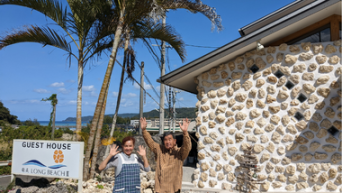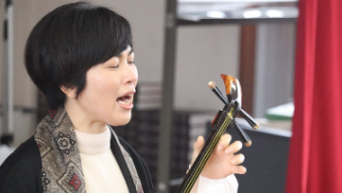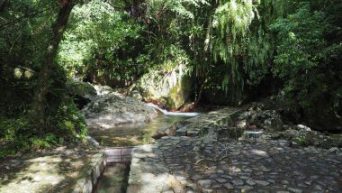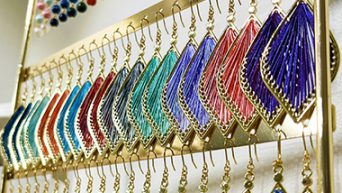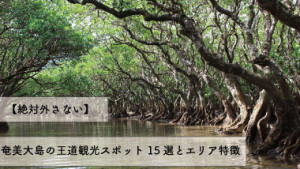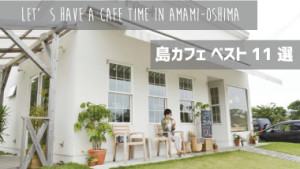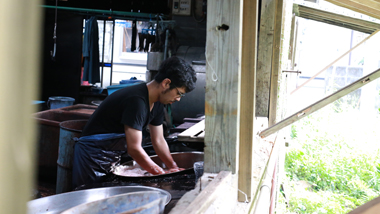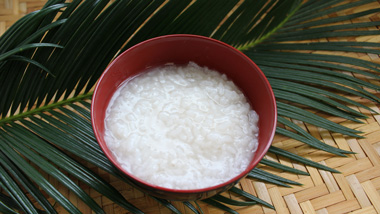You too can “Wander around Amami!” Vol. 1|Amami’s Treasure that Fully Utilizes Nature ‘Oshima Tsumugi’
島コト
2018/02/22
勝 朝子

Reads: Experience the route that Tamori visited in 6 courses; You too can “Wander around Amami!” Vol. 1 Amami’s Treasure that Fully Utilizes Nature ‘Oshima Tsumugi’
In his popular NHK television program “Bura Tamori,” Mr. Tamori, entertainment talent and master of strolling through towns, explores the region’s history and culture, as well as the lifestyle of the people as he wanders about. This “Bura Tamori” came to Amami Oshima in 2017.
*Translator’s note: The Japanese title of this article is “Bura Amami,” a play-on-words with the “Bura Tamori” television program title. The term “bura” means to wander, stroll, or roam.
In the unprecedented 3-part broadcast of “Bura Tamori” that aired from March to April 2017, the rich culture, history, and nature of Amami that can be said to be the foundation of Amami Oshima and that is unknown even to local islanders was introduced, and many discoveries were made.
In reference to the route from the television program, a writer for Amamikke is once again touring around Amami Oshima, and introducing anew the nature of Amami Oshima and the treasures of Amami that were cultivated in that.
It is a 6-part series that is separated by theme. Now, why don’t you too “Wander around Amami?”
You too can “Wander around Amami!” Vol. 2 | Exploring the hidden wisdom of rice cultivation on Amami
You too can “Wander around Amami!” Vol. 1|Amami’s Treasure that Fully Utilizes Nature ‘Oshima Tsumugi’

The theme of the journey in the 66th episode of “Bura Tamori” is “What is the ‘Treasure’ of Amami that Fully Utilizes Nature?”
Tamori, who visited Amami Oshima, was first surprised at the red soil. This old soil is high in iron content and is called ‘red-yellow soil.’
This soil is red because the iron comes into contact with air and is oxidized.
A start appropriate for a fan of geological features.
Let’s move on to the first destination, Kanai Kougei workshop of Toguchi in Tatsugo town.
Tour the ‘Mud-Dyeing’ Unique to Amami

We’ll learn at once about the treasure of Amami ‘Oshima Tsumugi’ from Kazuhito Kanai, who also taught Tamori of “Bura Tamori” about the secrets of dyeing Oshima Tsumugi.

“First, we chip then boil bits of the ‘techigi’ (sharinbai in Japanese) tree that grows naturally on the island. Once this is done it becomes a dark brown and reddish liquid.”
A reddish-brown liquid comes out from the chips of the tree that was boiled in a cauldron.
It is the cauldron that has the white fumes coming out from it. It is a very large cauldron indeed.

“If you soak and dye a pure white silk thread in that liquid, it will be dyed a light brown. This was dyed repeatedly 28 times.”
So, this is how dark it becomes if you dye it 28 times.
The color is from the dyes in the tree, which is said to also have tannic acid in it.

Then, we go to the mud field. This is the same mud field that Tamori was in.
At that time, he was saying “be quiet!” at the frogs who croaked in the background, but today it is quiet (haha).
“Now we put the mat of silk threads from just now into the mud field. We dye it like so to ensure it is thoroughly saturated. As we do this, look, it is turning a greyish color right?”
The tannic acid of the ‘techigi’ tree and the iron in the mud of the mud field react, thus it turns grey. If you repeat this process, then it turns the soft black that is characteristic of Oshima Tsumugi. How did our ancestors discover this chemical reaction? So mysterious.
Now, regarding why other areas have red soil but here the mud is black- the whole area of the mud field is wetlands, which acts like a lid and prevented it from being exposed to oxygen, so apparently the color of the iron remains black. It is a valuable mud field that is preserved by the terrain.
I understood that the dyeing method of Oshima Tsumugi that employs the blessings of nature is the ‘treasure’ that fully utilizes the nature of Amami.

And then, something even more amazing! As you use the mud field for a long time, the iron content decreases.
When this happens, the islanders put leaves from ‘sotetsu’ (Sago palm) into the mud field.
Although I do not understand the mechanism academically, it seems that is has been done that way since long ago.
If you write ‘sotetsu’ in kanji, it is written like ‘tetsu’ (iron) is being ‘revived.’
The mud flat is revived by the ‘sotetsu’ that grows on the island. This is also a method that fully utilizes nature.
Tamori was also moved by this on the TV program.
At Kanai Kougei workshop, they hold mud-dyeing experiences. How about you try out dyeing your own clothes or fabric with the natural materials of Amami?
◆ Kanai Kougei https://www.kanaikougei.com/
2205-1 Toguchi, Tatsugo-cho, Oshima-gun, Kagoshima Prefecture
TEL: 0997-62-3428
See, learn about, and try on Oshima Tsumugi!

We leave Kanai Kougei, and move on even further north.
This is the Oshima Tsumugi museum of the Thida Moon Resort Hotel in Tohama, Kasari town, Amami City.
Although it is a resort hotel, they also handle the production and sales of Oshima Tsumugi, so inside the premises is an Oshima Tsumugi museum and exhibition hall.
This Oshima Tsumugi museum is a special spot where you can observe the manufacturing process of Oshima Tsumugi, tour the Oshima Tsumugi and ‘basho-fu’ (Japanese fiber banana cloth) of ancient times, and even do a Tsumugi weaving workshop with Oshima Tsumugi thread, all for an entry fee of 500 yen.

In the TV program, after observing various beautiful Oshima Tsumugi works, Tamori took part in the “[kimono] Dressing” workshop, where they clip a roll of Tsumugi fabric into place to resemble a kimono.
At Thida Moon, if you apply ahead of time, then it is possible to take part in this dressing workshop free of charge.
This time, it was held by the chief manager Reiko Hoshika, and I gave it a try!

Oshima Tsumugi is certainly light (a mere 450g).
Seeing how the pattern comes together during the dressing, this workshop is a good method to use when picking one out for a kimono. You can also color coordinate the obi (belt) and decorative string that holds the obi in place.
Since it is a valuable opportunity, my accompanying cameraman (male) also tried the “dressing” workshop.
We were moved by how different it looked when we actually tried it from just seeing the fabric roll!
We both involuntarily said “I want it…”
Here they have an abundance of Oshima Tsumugi from not only Amami Oshima but also producing areas in Kagoshima and Miyakonojo, and you can purchase them at the production price.

The “treasure” of Amami that fully utilizes nature was Oshima Tsumugi, which makes the best use of things on Amami, such as ‘techigi,’ mud fields, and ‘sotetsu.’
The journey this time was one of coming to like the local Amami Oshima Tsumugi more and more.
◆ Amami Resort Hotel Thida Moon https://thidamoon.com/
1260-3 Taira, Kasari-cho, Amami-shi, Kagoshima Prefecture
TEL: 0997-63-0006
【Itinerary for this Journey】
Naze
↓ 30 min. by car
Kanai Kougei (Toguchi, Tastugo town) Mud-dyeing Experience 3 hrs
↓ 25 min. by car
Thida Moon Oshima Tsumugi museum (Tohama, Kasari, Amami City) Indoor Tour 30 min.
Thida Moon Dressing workshop @Oshima Tsumugi exhibiton hall 1 hr
↓40 min. by car
Naze
この記事を書いたフォトライター

勝 朝子
Webクリエイター、ITサポーター、奄美大島紬のポケットチーフ「フィックスポン奄美」代表。東京出身。縁あって奄美大島出身の夫と結婚。以来毎年奄美大島を訪れ、2012年奄美大島に移住。奄美の自然、人、文化、食べ物が大好きで、島の隅々まで日々探検中!
